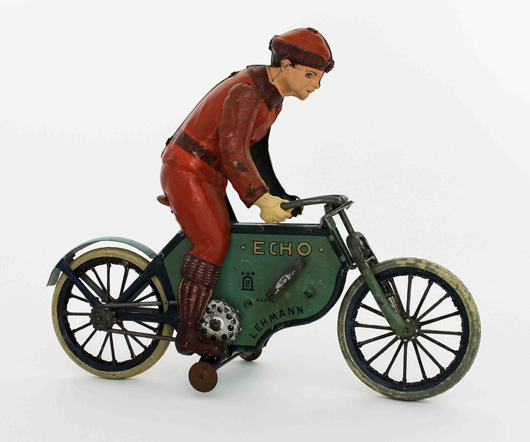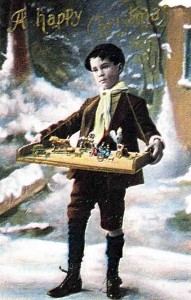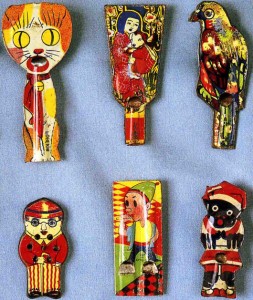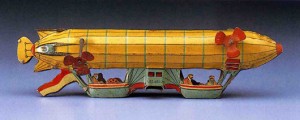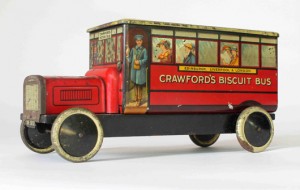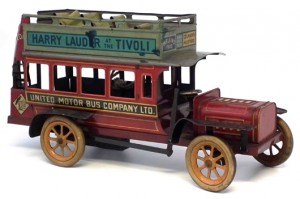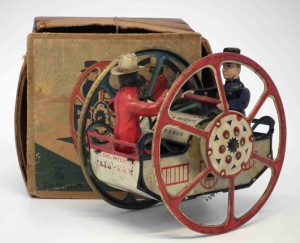LONDON – It’s about now that interest in those expensive toys Santa delivered is starting to fade. If they’re still working and in one piece, they eat batteries and anyway, all they do is go either up and down or round and round.
Things were less expensive back in 1899. In an article in The New Illustrated Magazine, one George Wade wrote: “The chief penny toy now most in demand is something of a mechanical kind, either in the shape of a working model or puzzle. The old kind of toy with no movement, but which was simply to be looked at is of no use today. People want moving engines, horses, steamers etc – and they want it for the nimble penny.”
When the article was written, it was already a craze among children and their parents to amass large collections of the penny novelties. Ah, how times change. In a 1957 issue of The Illustrated London News, Leslie Daiken, author of ‘Children’s Toys Throughout the Ages’, wrote: “They are like the cries of London. They belong only to yesterday but two world wars have made the actuality of the penny toy recede into what seems to be antiquity.
“Penny toys! There’s a rhythmic magic in the very phrase that would never sound as hypnotic if we said ‘ha’pennny’ or ‘tupenny’. Penny rattle! Penny whistle! This is the very coinage of late Victorian or Edwardian childhood, surviving only in its storybooks and jingles.”
Never a truer word, but even Leslie Daiken could not have imagined the value of penny toys today. They were sold originally by street hawkers who made them at home using scraps of wood, wire and paper. Then came the industrial might of Germany and the invention of machines to make cheap toys from tinplate. With mass-production, the market boomed, the most notable manufactory being founded by Ernst Paul Lehman in Brandenburg in 1881.
Lehmann toys are among the most coveted by collectors today. Look out for Tap-Tap, a man pushing a barrow, which was one of the firm’s best-sellers, and Tut-Tut, which was an early automobile with a sounding horn. His walking dog and crawling beetle were also popular, all driven by rudimentary clockwork motors.
Sophistication was not a word associated with penny toys. In Dancing Yankee, for example, “by placing the thumb and finger on his ears and pressing down on the top of his hat with the index finger, he shoots out his tongue in scorn, rolls his eyes, and moves his arms and legs as though afflicted with St. Vitus’s Dance” to quote the blurb.
Ancient Masher was another mechanical figure popular throughout the world. “When his string is pulled, the polite gent lifts his hat, which then springs back into place under the power of a concealed India rubber spring.”
Arguably the most popular tinplate penny toy was the climbing monkey chasing a nut up a string, a toy that has been around in one guise or another for much longer than a century. Examples can be found in many countries around the world, involving many different animals, all grappling to climb higher and higher as their string is pulled.
In England at the turn of the century, children were playing with Lehmann models of a London taxi cab and a double-decker autobus. Other cars, trucks and vans followed, as quickly as they rolled off the full-size production lines, while one of the most coveted toys among today’s collectors is the Lehmann Zeppelin airship, which first appeared in 1915. Expect to pay £5,000 ($7,578) or more for an example in mint condition, even more with its original box.
Another favorite was and still is the Mandarin toy of 1903, which has two pig-tailed bearers carrying a sedan chair occupied by an Oriental gent. Here, the clockwork mechanism powering the model is situated in the base of the chair. When activated, it pushes the model along at a rate of knots, the loose-jointed legs of the bearers scurrying to keep up.
World War I ended the German monopoly of tin toy manufacture in the world market, and other countries, notably the U.S., began to catch up where previously they had been left behind.
In fact, German-manufactured toys were virtually boycotted out of patriotism, but Lehmann managed to survive, later under the guidance of the founder’s cousin, Johannes Richter, when the founder’s health began to fail.
In the 1920s, the company employed more than 800 workers producing more than 80 different toys. E.P. Lehmann died in 1934 and the firm suffered another downturn when World War II meant steel supplies were diverted to the country’s war effort.
In 1949, on the division of Germany, the Lehmann factory was confiscated by the Russians, and Richter was forced to flee to West Germany leaving the Brandenberg factory to its fate.
However, in 1951, he managed to open a new factory in Nuremberg and production began once more. He died in 1956, but a third generation of the family continued the tradition of toy making with a company that thrives today, albeit under ownership of the other German giant in the industry: Märklin.
In my own meager collection of old and collectable toys is a modern Lehmann tinplate ladybird that gyrates and spins on plastic wheels, much to the amusement of all who see it. It cost somewhat more than a penny but, being driven by a powerful clockwork motor, thankfully does not require batteries.
These days late Victorian and Edwardian penny toys are highly sought after by children of all ages, but in the 100 years or so that have passed since the humble penny was enough to buy them, the value of antique toys has spiraled. Watch out for reproductions, though, which abound.
If you reckon conservatively on paying £1 for each year a penny toy has survived, it’ll give you a fair idea of how much you’re likely to have to pay. And at that kind of money, they are not for playing with. Instead, collectors treat them with reverence and keep them locked away in glass-fronted cabinets, protected from dust and corrosive elements. But they’d make a fine bequest to your grandchildren.



